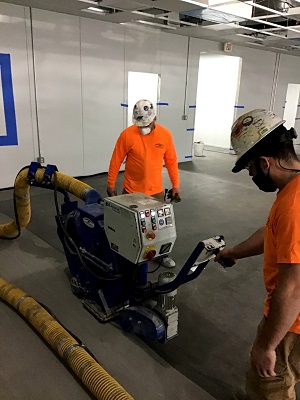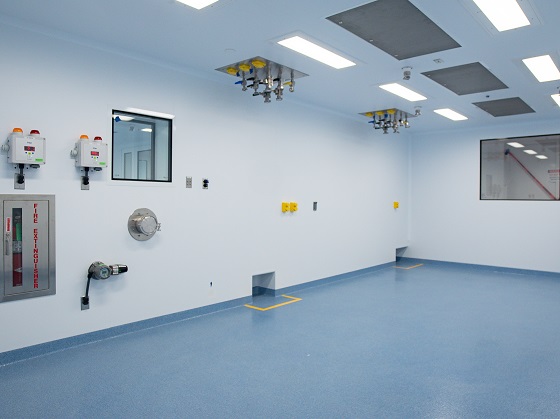In early 2020, pharmaceuticals manufacturer Arranta Bio found the concrete in its recently modified Watertown, Mass., facility in need of coatings work. The scope of the work included both older and freshly poured concrete floors, with the older concrete located in an already existing facility and newer concrete located in a recent buildout to that facility. Following a bid process, Black Bear Coatings & Concrete was chosen for the job.
“It was a state-of-the-art facility — a commercial-ready manufacturing building,” said Justin Tousignant, president of Black Bear Coatings & Concrete. He explained that the pharmaceutical company was expanding to advance its work in supplying materials to other pharma companies making advanced drugs to treat complex health conditions. In total, Arranta Bio had dedicated $100 million to the project.
Against the Clock
As Black Bear prepared to take on the Arranta Bio job, COVID-19 reached the United States. The wildfire-fast spread of the illness across the globe resulted in the World Health Organization declaring a pandemic on March 11, 2020. Precautionary restrictions suddenly became necessary to protect worker and client health, and it was only months before Black Bear was to begin its on-site work in July 2020.
In the early days of the pandemic, Black Bear implemented some measures of its own to get ahead of the problem: “We had a mask mandate we implemented on all jobsites, and when surrounded by other employees, just to minimize the actual spread itself,” said Tousignant. In addition to this, Black Bear “had already implemented our own COVID testing protocol [by July 2020], so we were testing employees twice a week with our PCR tests and monitoring.” According to Tousignant, these measures — along with Black Bear’s COVID-19-era policy of using only single-occupancy vehicles — helped create a safe working environment.
The size, scope, and number of trades involved on the Arranta Bio project also complicated things. Black Bear’s work, which comprised surface preparation and coatings applications, stretched over six months. However, this timeline took into account the fact that the coatings contractor would have to coordinate with the other trades, according to Tousignant, and Black Bear had a much shorter amount of time, overall, to do the work. Over the six months, “Our work took a total of 12 weeks…” Tousignant stated.
Pressure Cooker

In the facility, three different coatings systems were used, dubbed RES-1, RES-2, and RES-3 by Black Bear. These coating systems covered areas of 23,000, 7,000, and 11,000 square feet (2,136.8, 650.3, and 1,021.9 m2), respectively. Various Dur-A-Flex systems were used in these spaces, based both on the state of the concrete and Arranta Bio’s manufacturing needs.
Black Bear’s crew needed to work in phases in each area. These phases were dictated by room size and other trades’ needs at the time. “Well, we moved through the job pretty much like a snake…. We just prepped areas and then we would bring it to completion then we would move on to the next,” said Tousignant. He explained that crew members would cover 3,000–5,000-square foot (278.7–464.5 m2) areas at a time, with no one outside of the crew allowed to enter the area while the team worked. Six to eight crew members were present, which according to Tousignant, depended on the square footage of the area undergoing work.
To begin each area on the jobsite, Tousignant said that crew members shotblasted the surfaces with a Blastrac 1-10DPS75 while using standard personal protective equipment (PPE), including hard hats and ear and eye protection. They also used dust collectors. When areas could not be reached with shotblasting, Terrco 3100 grinders were used. The goal in all areas was to achieve an International Concrete Repair Institute (ICRI) concrete surface profile (CSP) of 2 to 3, depending on the system being installed in that area, Tousignant stated.
This work was not easy, as COVID-19 and phased applications were not the only challenges that affected this project. The heat of the summer, too, put pressure on the team because crew members were working in a nonclimatized space. In July alone, temperatures can reach 95 °F (35 °C) in the area, creating sweltering conditions for crew members. The heat also resulted in shorter-than-normal working times for the Dur-A-Flex systems that were installed, meaning that crews had to work faster to get things done.
Coat by Number
Each of the three areas required the same equipment during coatings applications: 4-inch (101.6 mm) cove trowels, 1/2-inch (12.7 mm) notched squeegees, loop rollers, flat squeegees, 3/8-inch (9.5 mm) mohair nap rollers, chip brushes, Portamix Mega Hippo mixers, and drills.
In the labs and clean rooms that made up the clean areas of RES-1, Black Bear’s crew applied Dur-A-Flex’s Hybri-Flex AQ at an average thickness of 3/16 inch (4.8 mm). According to Tousignant, Hybri-Flex AQ is “a decorative quartz flooring system that [consists] of a urethane cement [with] decorative quartz broadcast, epoxy [with] quartz broadcast, and [two] coats of a polyaspartic.” Dur-A-Flex’s website further notes that Hybri-Flex AQ has a moisture-tolerant body coat containing decorative quartz aggregate, as well as an Accelera topcoat that is chemical and abrasion resistant. Its multipronged approach to moisture, chemicals, and abrasion makes it suitable to labs and clean rooms while providing a decorative aesthetic.
Dur-A-Flex’s Hybri-Flex EB was chosen for RES-2. It was applied to an average thickness of 3/16 inch to the floors in the facility’s Good Manufacturing Practices (GMP) warehouse areas, as well as to the non-clean sides of the RES-1 areas. According to Tousignant, “It was a solid color (pigmented) flooring system that [consisted] of a urethane cement [with] sand broadcast, epoxy grout coat, and a polyaspartic [topcoat].” According to Dur-A-Flex’s website, the product can be used on both freshly poured and older, rougher floors.
RES-3 was applied in mezzanine areas. The products used in this system included: “epoxy primer (mitigation primer), epoxy grout coat, and urethane topcoat,” and they were applied to an average total thickness of 40–60 mils (1,016.0–1,524.0 microns). Product names include Dur-A-Glaze MVP Primer, Elast-O-Coat, and Dur-A-Gard 50/50.
A Happy Client
According to Tousignant, Arranta Bio was pleased with the work done by Black Bear over the course of the six months. However, Tousignant was not the only one to report this — in fact, the pharmaceutical company distributed a press release on September 29, 2020, celebrating the completion of the project and thanking “the numerous sub-contractors who have supported Arranta and worked through the pandemic in a safe and efficient manner.”
That means success. After all, a happy client is a happy contractor!
